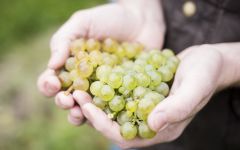Red Newt Cellars Curry Creek Vineyards Pinot Gris 2010


Product Details
Your Rating
Somm Note
Winemaker Notes






David and Debra Whiting met in the late 1980s when David was working as cellar master at a Finger Lakes winery and Debra was supervising microbiology labs at Cornell University. David’s oenological career blossomed as he worked at three different vineyards in Finger Lakes and Debra’s passion for food led her to start a gourmet cheesecake business and then an upscale catering company. The couple founded Red Newt Cellars in 1998 and Debra opened the Red Newt Bistro alongside the first wine releases in June of 1999. In 2011 Debra’s life was sadly cut short, prompting David to delegate some of his duties and hire a winemaker. In 2014 Kelby Russell, a Finger Lakes native, joined the team as the head winemaker.
Today, the Red Newt Cellars winery and Bistro are located in the small town of Hector in the Finger Lakes region of New York, on the southeastern corner of Seneca Lake. At 600 meters below sea level, Seneca Lake is the deepest of the Finger Lakes and one of the deepest lakes in the United States. The effects of the lake and the resulting range of surrounding altitudes and soil types create a wide array of unique terroirs in a relatively small area.
All of the vineyards Red Newt work with for their vinifera program are located on and around the Lake. To the Northwest, Nut Road is comprised of limestone and sandstone and produces an aromatic, delicate Loire Valley-style Cabernet Franc used for Kelby’s rosé. To the west sits Lahoma Vineyard, Red Newt’s largest vineyard. This land is all sandstone and is one of the highest vineyards in the area. The Knoll, a parcel within Lahoma Vineyard that is used to grow the benchmark Riesling for Red Newt, is the highest point at 1,600 ft. Nearby, lower-lying vines provide grapes for some of the other wines including the Circle Riesling and the Dry Riesling. Near the bottom of the lake is Tango Oaks, a compelling site that is a flood plain offering a mix of silt and loam on top of the bedrock. This site features Riesling planted to Alsatian clones, as opposed to the more typical German style Geisenheim ones, which brings an interesting tropical fruit finish to wines from this spot. The east bank of the lake is called the “Banana Belt,” a reference to its warm climate that farmers used to joke was well situated for banana growing. This microclimate is where you’ll find Red Newt’s red varieties, Cabernet Franc and Merlot.

Showing a unique rosy, purplish hue upon full ripeness, this “white” variety is actually born out of a mutation of Pinot Noir. The grape boasts two versions of its name, as well as two generally distinct styles. In Italy, Pinot Grigio achieves most success in the mountainous regions of Trentino and Alto Adige as well as in the neighboring Friuli—all in Italy’s northeast. France's Alsace and Oregon's Willamette Valley produce some of the world's most well-regarded Pinot Gris wine. California produces both styles with success.
Where Does Pinot Gris / Pinot Grigio Come From?
Pinot Gris is originally from France, and it is technically not a variety but a clone of Pinot Noir. In Italy it’s called Pinot Grigio (Italian for gray), and it is widely planted in northern and NE Italy. Pinot Gris is also grown around the globe, most notably in Oregon, California, and New Zealand. No matter where it’s made or what it’s called, Pinot Gris/Pinot Grigio produces many exciting styles.
Tasting Notes for Pinot Grigio
Pinot Grigio is a dry, white wine naturally low in acidity. Pinot Grigio wines showcase signature flavors and aromas of stone fruit, citrus, honeysuckle, pear and almond. Alsatian styles are refreshing, expressive, aromatic (think rose and honey), smooth, full-bodied and richly textured and sometimes relatively higher in alcohol compared to their Italian counterpart. As Pinot Grigio in Italy, the style is often light and charming. The focus here is usually to produce a crisp, refreshing, lighter style of wine. While there are regional differences of Pinot Grigio, the typical profile includes lemon, lime and subtle minerality.
Pinot Grigio Food Pairings
The viscosity of a typical Alsatian Pinot Gris allows it to fit in harmoniously with the region's rich foods like pork, charcuterie and foie gras. Pinot Grigio, on the other hand, with its citrusy freshness, works well as an aperitif wine or with seafood and subtle chicken dishes.
Sommelier Secrets
Given the pinkish color of its berries and aromatic potential if cared for to fully ripen, the Pinot Grigio variety is actually one that is commonly used to make "orange wines." An orange wine is a white wine made in the red wine method, i.e. with fermentation on its skins. This process leads to a wine with more ephemeral aromas, complexity on the palate and a pleasant, light orange hue.

As the most historic wine-producing region in New York state, winemaking in the Finger Lakes area dates back to the 1820s and today as a region, accounts for 90% of the state’s total wine production.
Its narrow and deep lakes created by the movement of Ice Age glaciers create an environment similar to the classic Riesling-loving regions of Europe, namely Germany and Austria. The Finger Lakes retain summer heat that incidentally warms up cold winter air, making it fall down from the lakes’ steep slopes. When spring comes, the lakes, already cooled by cold winter weather, stave off vine budding until the danger of frost has subsided. The main lakes of the zone, that is those big enough to moderate the climate in this way, are the focal points of prime vineyard areas. They include Canandaigua, Keuka, Seneca and Cayuga.
While Riesling has fueled most of the region’s success, today Pinot Noir and Cabernet Franc enjoy some attention.
